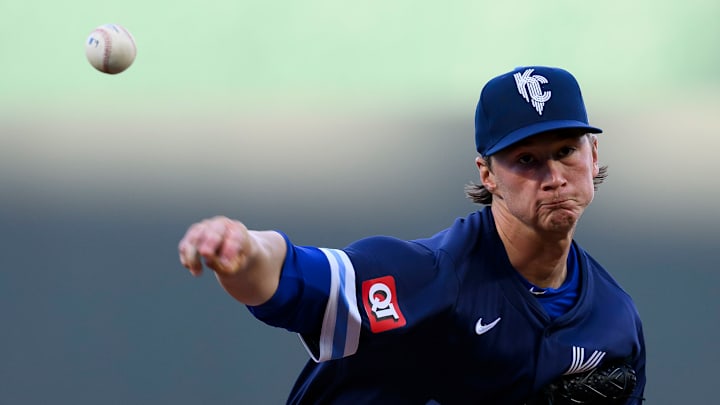I wondered what the KC Royals needed from Brady Singer for him to reach his potential. The Florida alum remains the top product of the failed 2018 draft class, but a down 2023 season threw his MLB ceiling into question. Would he be the top-of-the-rotation arm he looked like in 2022? Or would he be a questionable starter poised for a bullpen move?
In my opinion, there is no shame in a starter moving to the bullpen. Sometimes, a player's arm is better suited for short-inning work rather than pitching five-plus innings each appearance. But, I do feel Singer moving to the bullpen would have been a massive waste of talent. Thankfully, with one big change to his pitching repertoire, that possibility seems like a distant memory.
KC Royals pitcher Singer looks immensely better with a four-seam fastball.
For years, baseball minds wanted Singer to add a legitimate third pitch to his arsenal. His sinker-slider combination has always been his bread and butter, but another pitch could take Singer to another level. Still, despite PowerPoint presentations and calls from baseball's smartest outsiders, Singer continued deploying a two-pitch mix.
From 2020-2023, this is how Singer's pitching arsenal breaks down.
Sinker- 54.41%
Slider - 39.25%
Changeup - 5.79%
Four-seam Fastball - 3.83%
Sweeper - 1.57%
Ignore the astounding fact that 93.66% of his pitches across four seasons were either a sinker or Slider. Ignore 2023 where he stopped throwing a sweeper as quietly as he began throwing it that same season. Focus on the disparity in him throwing a four-seam fastball.
Singer only threw five such pitches in 2023 total, so minuscule it resides in Baseball Savant's margin of error. Only 11 starters, or pitchers with at least 1,500 pitches last season, recorded less than 3.8% four-seam fastballs. Obviously, Brady Singer was one such pitcher. Seeing his name listed alongside pitchers like Corbin Burnes and Logan Webb made me optimistic, but I backed up a bit.
Among those 11, Singer was still an outlier. He was the only pitcher to not throw three different pitches at least 10% across the season. Burnes, for example, relies on his cutter 55.4% of the time, the most among starters. But he still threw four different pitches at least 7.7% of the time, with his changeup and curveball residing in the double digits. This further shows Singer didn't need a four-seam fastball to succeed, but he needed to diversify his offerings.
Singer finally added a third pitch this season, throwing a four-seam fastball at 14.3% through two starts. He still throws a slider more often than not but mixes the four-seam in with his sinker. Singer spoke with MLB.com's Anne Rogers this offseason about his possible new offerings.
“It’s a different look for the hitters,” Singer said. “They can look horizontal with the slider and the sinker. Now being able to look up and down the zone, you change your eye level more. It’s going to be huge. Now it comes down to, ‘How am I going to use them all?’”
Despite the season being young, Singer is cautious in his use of the four-seam fastball. He has yet to throw it against any right-handed batter, reserving it solely for lefties, which is a strategic decision given the low velocity of his fastball. Furthermore, he mainly deploys it early in a plate appearance or as a two-strike pitch, using it not as his primary weapon, but rather as a tool to unsettle the opposing batter. In this way, the pitch serves as a means to knock the batter off balance, rather than as a get-out pitch.
So far, that has worked extremely well. Singer has recorded five outs on his fastball, with one strikeout and four weak groundouts. The limited quality contact on Singer's fastball is surprising, posting the lowest exit velocity among his three pitches and not allowing a single hard-hit ball yet. This groundout against the Chicago White Sox demonstrates the pitch's use and value perfectly.
How much better will Brady Singer be with this new pitch?
Singer maintaining his current .68 ERA across an entire season would be unheard of, but his predictive stats are very promising. His 2.12 expected ERA (xERA) ranks 19th amongst MLB starters, with a 2.43 expected FIP (xFIP) ranking 8th, according to FanGraphs. His strikeouts are enough to be potent, his arsenal is under control, and he is limiting hard-hit balls across the board. What isn't to like?
I get that sabermetrics aren't for everyone, but even if you are relying on the eye test, you can tell Singer is a better pitcher this year. 2023 wasn't an easy season for Singer, and he clearly wants to be better in 2024.
“Last year, I was trying to learn new things while I was struggling," Singer said. "I knew what I had to fix and knew it would help me this year. Now, it’s about using those pitches in the right way and competing like I know how.”
Singer's future in the rotation has been revitalized by adding the four-seam fastball. This move showcases his competitive nature. With Kansas City's offseason additions and Cole Ragans' resurgence, Singer felt like he was backed against a wall. However, he has been reminding fans of his MLB potential in 2024. The question that arises now is how long will his success last.
